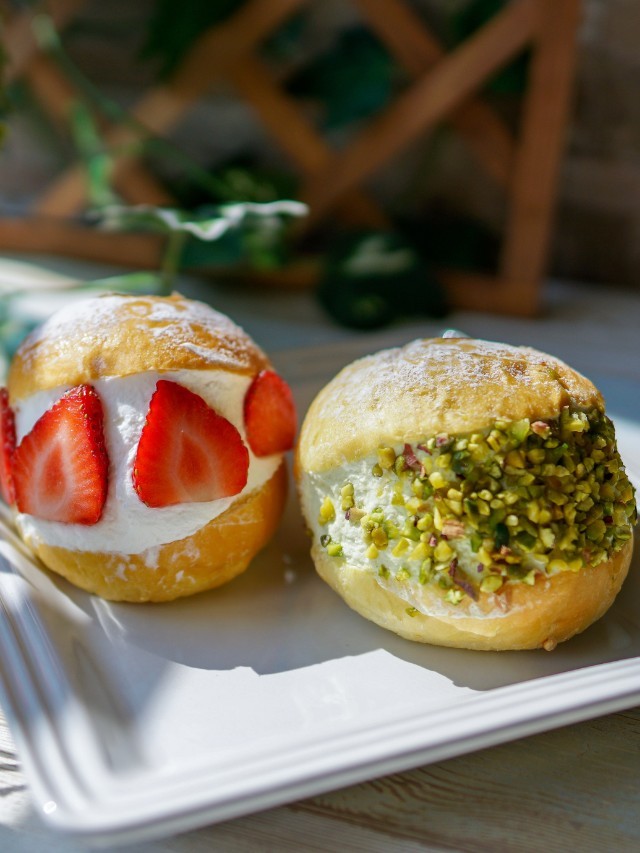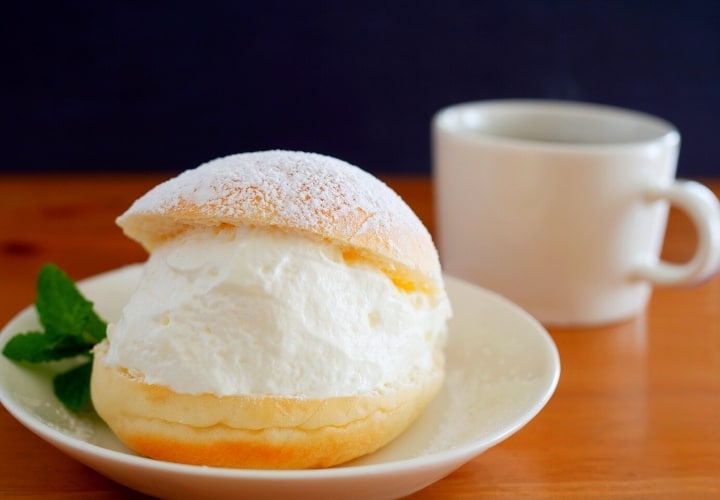Greetings, folks! Today, we’ll show you how to make Maritozzi Con La Panna, or sweet buns with whipped cream, a traditional Italian sweet bun.
Maritozzi are beautiful and tasty Italian cream buns. It’s a brioche-style soft and light bun that’s divided in half and filled with whipped cream! You may easily find one in a pastry store or a coffee shop in Rome. In Italy, these buns are usually served with coffee during breakfast or with a cup of tea in the afternoon.
After making Filipino Ensaymada buns, and Japanese Cream Pan, it’s time for these delicious Italian Maritozzi buns. Also, if you love Italian recipes, you don’t want to miss this Famous Sicilian Cannoli Authentic Recipe and these irresistible Canestrelli cookies.
What is Maritozzi?
Maritozzi buns date back to the Middle Ages and originated in the Lazio district of Rome. Flour, egg, yeast, sugar, honey butter, salt, and orange zest (or lemon zest) are ingredients used to make authentic Italian Maritozzi buns.
The term is derived from the slang corruption of the word “marito.” Maritozzo or “marito” at the time was well-known to famed Roman poet Gioacchino Belli who observed that “during lent, everybody eats maritozzi at the Caffetteria as they had never dined before.”
He would also have recognized that young lovers would deliver them as Valentine’s Day present on the first Friday in March. A groom-to-be would get a huge maritozzo topped with sugar and containing a ring or a little golden item from his future wife.
As a result, the term maritozzo evolved to imply “husband.” According to another tradition, the girls who prepared the greatest maritozzi were more likely to find spouses well before the rest of the girls.
Maritozzi An Old Tradition
Bread flavored with honey and raisins existed as early as the Roman era. For centuries, women have made identical ‘pagnotelle’ to fit inside the saddlebags of workers who, although away from home all day, may get food on hand.
They shrank in size throughout the years to become a bun. They were so subtle that they were the sole sweet allowed during Lent when the laws of fasting were particularly severe when it came to butter.
They even got the title ‘Er Santo Maritozzo’.
Of course, Rome has a plethora of pastry shops and coffee shops selling cakes, pastries, and sweets, but the maritozzo, the King of Roman sweet bread, will always have a place. After decades of neglect, the maritozzo is making a comeback in Rome… and in style.
A delicious maritozzi must be loaded with ‘Panna montata’ cream and should be both exquisite and delicate. Bakery-made Marioizzi is even lighter than pasticcerie-made, which are richer and less delicate. Enjoy Maritozzi as a delicious treat in the afternoon or with a cup of coffee in the morning.
Check out this Italian Lemon Ricotta Cake!
Maritozzo Day
On Saturday, December 4, 2022, Rome celebrates Maritozzo Day, a yearly celebration of the maritozzo. Maritozzo Day, now in its fifth iteration, is devoted to commemorating the well-known Roman dessert, from the traditional cream-filled form to more daring variants.
The event’s organizers, Tavole Romane, encourage customers to visit their go-to maritozzo vendors so they may “enjoy each bite leisurely” and share maritozzo images and videos on social media.
There will be plenty of pastry shops, bakeries, and pizzerias in the capital and beyond where you may sample this distinctive treat that represents the Eternal City and is beloved across Central Italy and beyond!
Maritozzi Recipe
There are many versions of traditional recipes. The Marchigiani Maritozzi is the most well-known and loved. Today I will share the original Maritozzi con La Panna recipe. This recipe is easy and accessible for all.
The Maritozzi must be coated with sugar syrup after they have been cooked. This is necessary to give them a glossy appearance. Once they have cooled, they should be cut in half lengthwise (or more) and filled up with whipped cream. You will taste the authentic flavor and smell of real Maritozzi with super soft, homemade cream.
If you ever find yourself in Rome, you should visit IL MARITOZZO ROSSO and try their Maritozzi. Because this is where my inspiration for this recipe came from.
So, without further due, let’s jump into this Maritozzi Con La Panna Recipe!
Ingredients
For the buns:
-
2 tsp active dry yeast
-
1 Tbsp honey
-
3 cups all-purpose flour (spooned and leveled; see notes)
-
1/3 cup bread flour (or just use all-purpose if you don’t have bread flour)
-
1 cup lukewarm milk
-
1/3 cup sugar
-
1/2 tsp kosher salt
-
5 Tbsp unsalted butter, softened and cut into pieces
-
2 Tbsp olive oil, plus more for greasing
-
3 large eggs, room temperature
-
2 tsp orange or lemon zest, grated
-
Optional: 1/4 cup raisins (about 50g), added after mixing dough
For the syrup and filling:
-
3 Tbsp sugar
-
3–4 Tbsp water
-
1 cup heavy cream, cold
-
Powdered sugar, to taste
-
(Optional: splash of vanilla or orange blossom water for the cream)
Instructions
-
Activate the Yeast:
In a large bowl, whisk together the lukewarm milk, yeast, and honey. Let it sit for about 10 minutes until bubbly. -
Make the Starter:
Stir in 1/2 cup of the all-purpose flour to form a loose batter. Cover with plastic wrap or a kitchen towel and let it rise for 20 minutes. -
Mix the Dough:
In the bowl of a stand mixer, add the remaining all-purpose flour, bread flour, sugar, and salt. Add the eggs, orange or lemon zest, and the bubbly yeast mixture. Mix on low speed (using a dough hook, if you have one) until just combined. -
Add Butter and Oil:
With the mixer running on low, add the softened butter, one piece at a time, letting each piece fully incorporate before adding the next. Drizzle in the olive oil and continue mixing. If using, fold in the raisins. Increase to medium speed and knead for about 8–10 minutes. The dough should be soft and slightly tacky—add a tablespoon of flour at a time only if the dough is too sticky to handle, or a tablespoon of milk if it seems dry. (Dough textures can vary depending on flour brand and egg size.) -
First Rise:
Lightly oil a large bowl. Transfer the dough, cover, and let rise at room temperature until doubled in size, about 1½ hours. -
Shape the Buns:
Line two large, rimmed baking sheets with parchment paper. Turn the dough onto a lightly floured surface and divide into 10 equal pieces. Roll each piece into a ball, then gently shape into ovals about 5 inches long. Space them at least 2 inches apart on the baking sheets. -
Second Rise:
Cover the buns loosely with a kitchen towel or plastic wrap. Let them rise in a warm place until puffy and nearly doubled, about 40 minutes. -
Bake:
Preheat your oven to 350°F (175°C). If you want a shiny finish, brush the buns lightly with beaten egg before baking. Bake for 15–18 minutes, rotating the trays halfway through, until golden brown. -
Make the Syrup:
While the buns bake, combine the sugar and 3–4 Tbsp water in a small saucepan over medium heat. Stir until the sugar dissolves and the syrup simmers for 2 minutes. Remove from heat and let cool slightly. -
Finish the Buns:
While the buns are still warm, brush them generously with the syrup. Cool completely on a wire rack. -
Fill and Serve:
Whip the cold cream with powdered sugar (and vanilla/orange blossom water, if using) until it holds firm peaks. Once the buns are cool, slice each one down the middle (but not all the way through) and fill generously with whipped cream. Dust with powdered sugar, if you like. Serve right away.
Recipe Notes:
-
Flour brands and humidity can make a difference in dough texture. Add extra flour or a splash more milk if needed—the dough should be soft, slightly sticky, and easy to handle with lightly oiled hands.
-
For a traditional look, add raisins to the dough.
-
You can use all-purpose flour if you don’t have bread flour—the result will be just a bit softer.
Please share the image below to your Pinterest board if you like this Maritozzi recipe!
Maritozzi Video Recipe
Dive into the world of Maritozzi mastery with skilled Fabrizio! See a slightly more complicated version of this delicious treat that is well worth your time and attention.
Conclusion
Maritozzi buns are hands down the best sweet buns I’ve ever tasted and made. Italians know their pastry, that’s for sure! I hope you take your time and try this Maritozzi recipe yourself, and if you do, please let me know how it turned out for you by commenting here. Also, if you’re having any difficulty with the Maritozzi recipe, please let me know, and I’ll reply. Thank you!







Will these still work if you use 100% AP flour? I don’t have bread flour…Beautiful pictures by the way!
Hey there Monika, yes you can. However, do consider that bread flour contains a higher amount of gluten and gluten is what gives baked goods structure.
Yours show raisins in them, but none are included in the recipe. Can you tell me how much you’d suggest and how/where it should fit in the recipe?
Hey Tim, sure! Raisins are optional you can add around 1/4 cup (50 grams), and you can incorporate them into the dough once the dough is ready. Just pour the raisins over the dough and then fold it.
Are 1/3 cup of milk and the 3 eggs all the fluids in this recipe? my dough came very stiffly
Hey Oren, thanks for catching that! The recipe actually calls for a full cup of lukewarm milk, not just 1/3 cup, along with the eggs and other wet ingredients. I’ve updated the recipe to clarify that point and to help avoid confusion. If you try again, the dough should be much softer. Thanks for your comment—it helps a lot!
Something is missing in your recipe, I am making the dough now and it is tough, I make breads and pastries often when I was making th dough it felt like it was missing something, after the first rise, it’s definitely missing moisture.
Hi Lance, thanks for letting me know. The dough should actually be on the soft and slightly tacky side, not tough—so you’re right, it sounds like it needed a touch more moisture. Sometimes flour brands or kitchen climate can throw things off, so I’ve updated the recipe to suggest adding a little milk if the dough feels dry or stiff. I really appreciate your insight!
Bad recipe and instructions
Hey J, I’m sorry you had a frustrating experience. I’ve updated the recipe instructions to be much clearer, especially around mixing the dough and adjusting the texture. If you’re willing, I’d love to know where things went wrong for you so I can keep improving the recipes. Thanks for your honesty!
The recipe calls for 3C of all purpose flour and 1/3C of bread flour. My dough was so sticky, I had to add over another cup of flour. Is the recipe correct??
Hey Andrea, thanks for your feedback! The dough for Maritozzi is naturally pretty soft and a bit sticky, but it shouldn’t be so wet that you need a full extra cup of flour. Sometimes the dough texture varies depending on your flour brand, the size of your eggs, or even the humidity in your kitchen. I’ve updated the recipe to include tips for adjusting with a little extra flour if it’s too sticky to handle, or a splash of milk if it’s too stiff. I hope you’ll give it another try with the new notes! Let me know how it goes next time.